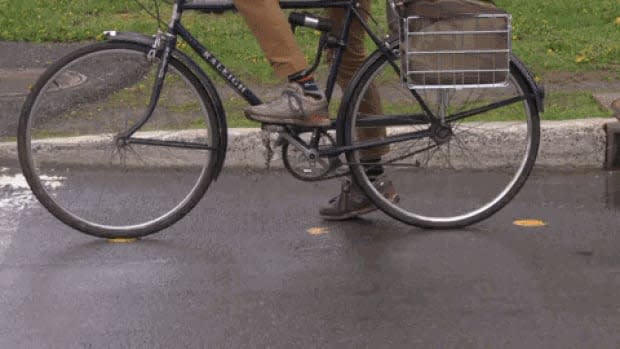New technology will end 'scary' red reverts at hundreds of Ottawa intersections

Cyclists are expressing some relief over new software designed to cut down on the potentially dangerous traffic signal trend of red reverts.
The "amber lock" is made-in-Ottawa software that's set to be rolled out at hundreds of intersections with high volumes of cyclists.
Red reverts occur when vehicles, including bicycles, cause sensors in the road to trigger a traffic light change.
The sensor technology is meant to speed the flow of traffic through intersections. But if the vehicle or bicycle moves past the sensors too soon, the signal immediately switches back to red and the cross traffic gets a green light again.
That can leave cyclists caught in the middle of an intersection as the traffic signal is changing.
Instead of that happening, the amber lock guarantees the opposing traffic signal will stay red for at least 10 seconds, giving them more time to cross the intersection, said Phil Landry, the city's director of traffic services.

"It's a huge relief," said Somerset Coun. Catherine McKenney, an avid cyclist who's heard concerns about the red revert technology for years.
"[We've had our] fingers crossed that nobody would get caught in a red revert."
Érinn Cunningham, president of Bike Ottawa said he's been caught in an intersection because of a red revert, something he said is "pretty scary."
Cunningham said he's heard from many others who've had similar experiences.
"There can be a lot of traffic and it can be moving at a significant speed," Cunningham said. "So, it's a pretty vulnerable feeling."
192 intersections
The software is unique to Ottawa, with the programming done by a consultant at a cost of about $46,000, said Landry. It's currently being tested at the city's traffic control centre before a planned rollout by the end of June.
"We're not aware of any other municipality in North America that's created this feature," Landry said.
He said the city also plans to include an automatic walk signal at intersections where the amber lock is triggered, ensuring pedestrians don't have to wait a full traffic cycle before being able to cross if they didn't press the walk button.
While the city plans to roll out the software at 192 intersections — the city has roughly 1,200 — Landry said that number will likely increase after consultations with councillors, residents and the cycling community.
Cunningham said he wants to see the technology rolled out at every intersection across the city. McKenney expects all intersections coming off the city's multi-use pathways will have the amber lock, along with every intersection within Somerset ward that doesn't automatically change.
"I'll be honest. I can't see that there's an intersection in the downtown where there isn't a high number of cyclists that use the intersection," McKenney said.
McKenney also said providing safer cycling infrastructure could encourage people to leave their cars behind.
"We have to start somewhere and to get more people out of their cars. We have to provide that safe infrastructure for them."

 Yahoo Movies
Yahoo Movies 